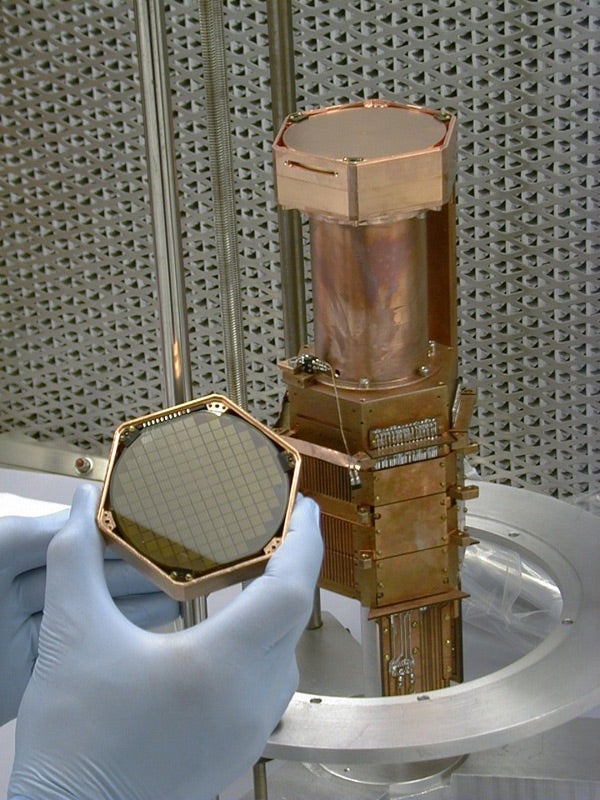
February 27, 2008
Scientists of the Cryogenic Dark Matter Search (CDMS) experiment, including researchers from the California Institute of Technology, have announced that they have regained the lead in the worldwide race by a number of different research groups to find the particles that make up dark matter. The CDMS experiment, which is being conducted a half-mile underground in a mine in Soudan, Minnesota, again sets the world’s best constraints on the properties of dark matter candidates.
Weakly interacting massive particles, or WIMPs, are leading candidates for the building blocks of dark matter, the as-yet-unknown form of matter that accounts for 85 percent of the entire mass of the universe. Hundreds of billions of WIMPs may have passed through your body as you read these sentences.
The CDMS experiment is located in the Soudan Underground Laboratory, shielded from cosmic rays and other particles that could mimic the signals expected from dark matter particles. Scientists operate the ultra-sensitive CDMS detectors under clean-room conditions at a temperature of about.04° C above absolute zero. Physicists believe that WIMPs, if they exist, would travel right through ordinary matter, rarely leaving a trace. If WIMPs were to cross the CDMS detector, occasionally one would hit the nucleus of an atom of the element germanium in the crystal grid of the detector. Like a hammer hitting a bell, the collision would create vibrations of the grid, which scientists would be able to detect. The experiment is sensitive enough to hear WIMPs if they hit the crystal germanium detector only twice per year.
The scientists did not observe such signals, allowing the CDMS experiment to set limits on the properties of WIMPs.
Scientists predict that WIMPs might interact with ordinary matter at rates similar to those of low-energy neutrinos, elusive subatomic particles discovered in 1956. But to account for all of the dark matter in the universe and the gravitational pull it produces, WIMPs must have masses about a billion times larger than those of neutrinos. The CDMS collaboration found that if WIMPs have 100 times the mass of protons (about 100 GeV/c^2) they collide with one kilogram of germanium less than a few times per year; otherwise, the CDMS experiment would have detected them.
“With our new result we are leapfrogging the competition,” says CDMS co-spokesperson Blas Cabrera, Stanford University. The Department of Energy’s Fermi National Accelerator Laboratory hosts the project management for the CDMS experiment. “We have achieved the world’s most stringent limits on how often dark matter particles interact with ordinary matter and how heavy they are, in particular in the theoretically favored mass range of more than 40 times the proton mass.”
“The CDMS experiment is unique in bringing so many different disciplines to bear on the search for dark matter, from astro- and particle physics in the expected WIMP signature to low-temperature and condensed-matter physics in the operation of our novel detectors,” says Sunil Golwala, assistant professor of physics at Caltech. “Our work continues Caltech’s long-standing role in the dark matter story, ranging from the first evidence for dark matter obtained by Fritz Zwicky in 1933 to the detailed maps of dark matter made recently by Caltech astronomy colleagues Nick Scoville, Richard Ellis, and Richard Massey.”
“Observations made with telescopes have repeatedly shown that dark matter exists. It is the stuff that holds together all cosmic structures, including our own Milky Way. The observation of WIMPs would finally reveal the underlying nature of this dark matter, which plays such a crucial role in the formation of galaxies and the evolution of our universe,” says Joseph Dehmer, director of the Division of Physics for the National Science Foundation.
The discovery of WIMPs would require extensions to the theoretical framework known as the standard model of particles and their forces. The CDMS result, presented to the scientific community at the Eighth UCLA Dark Matter and Dark Energy symposium on February 22, tests the viability of new theoretical concepts that have been proposed.
“Our results constrain theoretical models such as supersymmetry and models based on extra dimensions of space-time, which predict the existence of WIMPs,” says CDMS project manager Dan Bauer, of DOE’s Fermilab. “For WIMP masses expected from these theories, we are again the most sensitive in the world, retaking the lead from the Xenon 10 experiment at the Italian Gran Sasso laboratory. We will gain another factor of three in sensitivity by continuing to take more data with our detector in the Soudan laboratory until the end of 2008.”
A new phase of the CDMS experiment with 25 kilograms of germanium is planned for the Sudbury Neutrino Observatory’s underground laboratory facility in Canada.
“The 25-kilogram experiment has clear discovery potential,” says Fermilab director Pier Oddone. “It covers a lot of the territory predicted by supersymmetric theories.”









